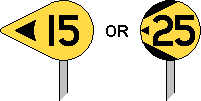Queensland (Australia)
(Page 1 of 1)
Despite many differences, modern signalling in Queensland adheres to British principles more closely than in any other Australian state.
Colour light signals showing red, yellow and green aspects are used extensively in Queensland. The Brisbane suburban area has four-aspect signals that are also capable of displaying double yellow aspects, and its running lines are fitted with the British Automatic Warning System (AWS). Signals are provided with the same types of route indicators as are used in Great Britain, where required.
The application of flashing signal aspects in Queensland bears no resemblance to British practice. A signal displays a flashing single yellow aspect when a warner route is set to the next stop signal beyond. This is more restrictive than a steady yellow aspect and instructs the driver to proceed to the next stop signal at a speed not exceeding 40 km/h. The flashing double yellow aspect is not used in Queensland. A flashing green aspect exhibited by a signal at the end of Remote Control Signalling territory (the equivalent of British Track Circuit Block) allows the train to proceed providing the driver has the relevant authority applicable to the alternative system of signalling beyond.
|
An 'approach beacon' functions as a fixed distant signal, and a driver passing it must be prepared to stop the train at the next signal. It comprises an inverted triangle with yellow and black horizontal stripes [QD.1].
|
 |
|
[QD.1] Approach Beacon.
|
|
|
Some colour light signals are equipped with a dynamic speed indicator (DSI). A DSI has a similar form to a standard alphanumeric route indicator, but instead of route indications, it can display different speed values in white illuminated figures [QD.2]. It is usually mounted below the main signal head. A speed indication is only displayed when the associated signal is showing a single yellow aspect and the next signal is displaying either a yellow aspect (for a diverging route) or a flashing yellow aspect (for a warner route). The speed displayed by the DSI is the maximum speed (in kilometres per hour) at which the train is permitted to pass the next signal.
|
 |
|
[QD.2] Dynamic Speed Indicator (e.g. "40" displayed).
|
|
The standard form of shunting signal in Queensland is a position light signal that displays aspects which are the mirror image of their British counterparts. It therefore shows the red light on the right of the white light when 'on' [QD.3], and the two white lights are inclined at 45° in the lower quadrant when 'off' [QD.4].
 |
 |
|
[QD.3] Position Light Shunting Signal ('on').
|
[QD.4] Position Light Shunting Signal ('off').
|
A movement from a colour light signal towards a siding or loop may be authorised by the illumination of a yellow light offset to the appropriate side of the main red aspect. This is termed a 'siding signal' and is similar to the miniature yellow aspect in Britain (see [4.86]).
Main signals that cannot display a red aspect are termed 'approach signals' and are identified by being fitted with a miniature approach beacon [QD.5].
A repeat signal in the form of a two-aspect colour light may be installed on approach to a main signal with restricted sighting. The repeat signal shows a yellow aspect (or a flashing yellow aspect if the previous signal displayed a flashing yellow aspect) when the main signal is at 'danger', and a green aspect when the main signal is exhibiting any 'proceed' aspect. A repeat signal is fitted with a circular yellow sign bearing the letter "P" [QD.6] (the letter "P" in electrical signalling nomenclature stands for "repeating"). There are a few UK-style banner repeaters (see [7.55 & 7.56]) in Queensland, and these are also fitted with "P" plates.
 |
 |
|
[QD.5] Approach Signal Sign.
|
[QD.6] Repeat Signal Sign.
|
Reminder boards are installed as a SPAD prevention measure in certain places. A signal reminder board depicts the image of a colour light signal with the distance to the signal beyond indicated below [QD.7]. An AWS reminder board comprises a blue background with a picture of an AWS 'sunflower' cab indication between the words "check" and "AWS" [QD.8]. AWS reminder boards are usually installed at stations where the signal beyond is not visible from the platform.
 |
 |
|
[QD.7] Signal Reminder Board.
|
[QD.8] AWS Reminder Board.
|
Ordinary permanent speed signs have black figures on a circular yellow background [QD.9]. The figures give the permitted speed in kilometres per hour. A permanent speed sign that applies to a diverging route incorporates a black triangle pointing in the appropriate direction [QD.10]. Permanent speed signs that are only applicable to tilting trains are rectangular in shape [QD.11].
 |
 |
 |
|
[QD.9] Permanent Speed Sign.
|
[QD.10] Permanent Speed Sign (e.g. applicable to left-hand divergence).
|
[QD.11] Permanent Speed Sign applicable to Tilting Trains.
|
|
A whistle board bears an elongated letter "W" in black on a white trapezium-shaped background [QD.12].
|
 |
|
[QD.12] Whistle Board.
|
|
|
A signal in an electrified area may be provided with a non-wired route indicator, which displays an illuminated white diagonal cross [QD.13] when a route is set towards a non-electrified line. Electric trains must not pass a signal displaying this indication.
|
 |
|
[QD.13] Non-Wired Route Indicator.
|
|
|
The equivalent of the British "off" indicator (see [20.2]) is the signal aspect indicator (also known as a guard's repeater). When the relevant stop signal is displaying a 'proceed' aspect, the signal aspect indicator displays an illuminated representation of a lower quadrant semaphore arm in the 'off' position [QD.14].
|
 |
|
[QD.14] Signal Aspect Indicator.
|
|








